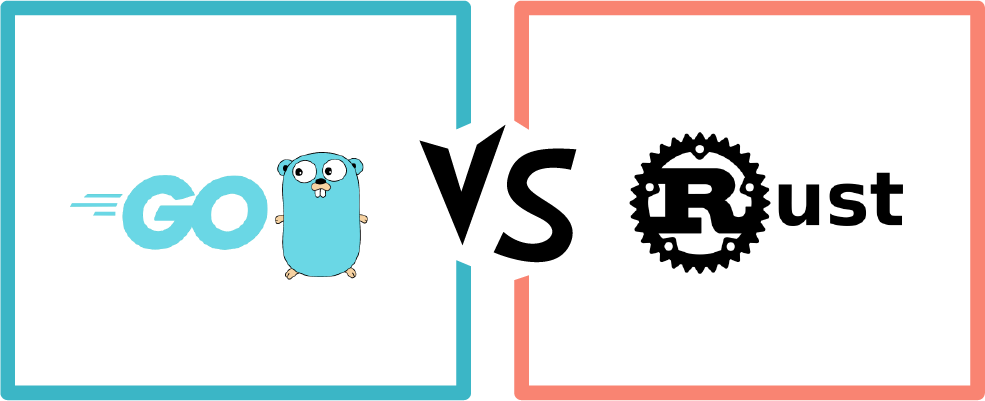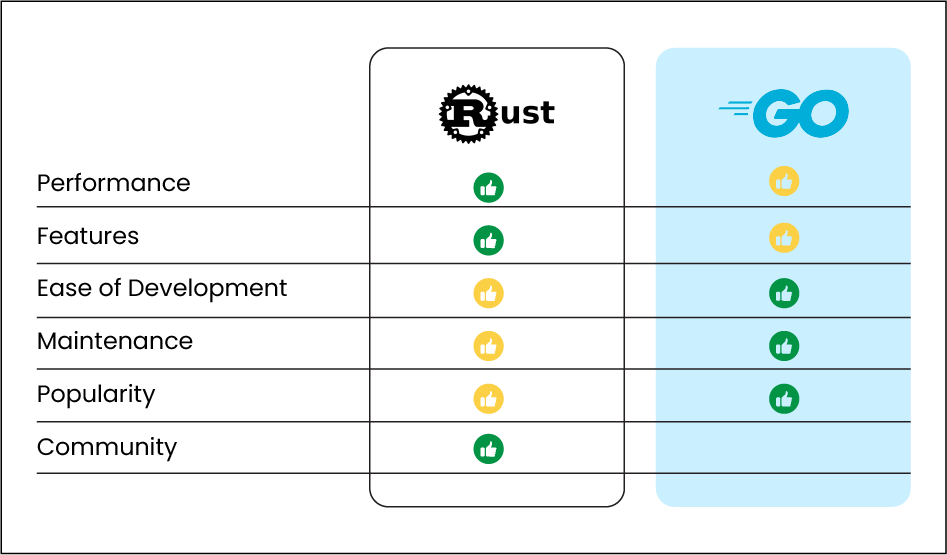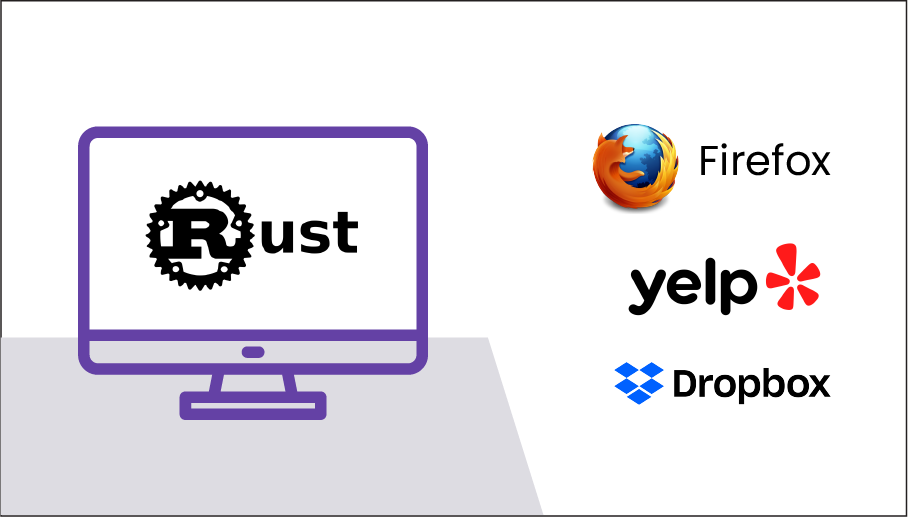- March 20, 2024
- Posted by: Kavitha V Amara
- Category: Application Engineering


As we are near the end of 2023, pursuing optimal tech solutions remains as crucial as ever. For startups navigating this dynamic environment, the choice of programming language can significantly impact operations, particularly in application engineering, product engineering, and low code. In this context, the debate between Go and Rust takes center stage, offering distinct advantages for those willing to explore beyond the mainstream options.
Golang and Rust hold a unique distinction in programming languages, having emerged in the early 2000s and 2010s. This sets them apart in a landscape dominated by languages with roots stretching back centuries.
When thoroughly examining Golang versus Rust, it becomes evident that these two languages share notable similarities. However, a closer inspection of six important categories revealed that
This head-to-head comparison delves into the languages’ attributes, including:
- Performance
- Features
- Ease of Development
- Maintenance
- Popularity
- Community
This article aims to shed light on the distinctions between each language, providing valuable insights to guide your decision-making process for your tech stack. Continue reading to discover the key differentiators!
Golang vs. Rust: Side-by-Side Comparison
Explore this direct comparison between Golang and Rust. This detailed analysis ensures that you can make an informed decision based on the specific features and capabilities that matter most to you in your chosen programming language.

Performance:
Go and Rust both put a strong emphasis on performance. Being relatively new languages, they are designed to perform well and surpass their predecessors.
While both languages excel in terms of speed and efficiency when compared to other programming languages, the crucial question is: how do they measure up against each other? Through rigorous benchmark testing, it becomes evident that Go and Rust each have their areas of strength, with neither consistently outperforming the other.
TLDR: Regarding speed and performance, both Go and Rust demonstrate commendable capabilities, each with its areas of proficiency.
Features:
While Go brings notable strengths to the table with its efficient binaries and reliable package management, Rust offers an extensive set of equally impressive features. These encompass zero-cost abstraction, obvious error messages, move semantics, robust data race prevention, and comprehensive pattern-matching capabilities.
TLDR: Both Go and Rust offer robust capabilities, each catering to specific programming needs without significantly overshadowing the other.
Ease & Speed of Development:
Go’s emphasis on readability and simplicity renders it a highly accessible language, making the learning curve relatively smooth. In contrast, Rust introduces intricate concepts like borrowing and ownership, which can pose a steeper learning curve for developers. Rust openly acknowledges its learning curve.
TLDR: Go offers a more straightforward learning experience, and Rust’s advanced concepts contribute to a steeper learning curve. The choice ultimately depends on your comfort with these concepts. It’s not a clear-cut win for either language in this category.
Maintenance:
Maintenance encompasses the tasks required to ensure your programs’ smooth operation and longevity. In this regard, Go holds an advantage, as its codebase is inherently simpler, making maintenance tasks more straightforward. With its added complexity, Rust may entail a more intricate maintenance process.
TLDR: Go’s simplicity lends itself to easier maintenance than Rust, which involves more intricate upkeep due to its inherent complexity. In this category, Go holds an advantage.
Community:
The open-source languages community is a thriving community of developers that is instrumental in aiding newcomers in mastering the language’s nuances and best practices. Evaluating the strength of a community, however, is subjective. If we see both Rust and Go communities, both communities often garner significant praise, underscoring their vibrancy and support. This recognition indicates a solid and active community.
TLDR: Rust and Go benefit from thriving communities, but Rust’s community visibility stands out in this comparison. It’s important to note that both communities are strong in their own right. This category is more evenly matched.
Popularity:
Defining the popularity of relatively young languages like Go and Rust can be challenging. Despite their impressive features and advantages, they have yet to reach the widespread adoption of more established languages like JavaScript, Python, or Java.
According to Stack Overflow, less than 10% of developers currently utilize Rust or Go. However, it’s worth noting that Go holds the 14th position in the rankings for top languages, while Rust trails behind in the 26th spot, as per the TIOBE Index for January 2022. This index considers various factors, including search engine popularity, presence in computer science courses, and endorsements from skilled engineers.
TLDR: In comparing Golang and Rust, Go enjoys more popularity than Rust.
Now that we’ve explored the side-by-side comparison of Golang and Rust, let’s explore deeper into each language individually.
What Is Golang?
Golang, also known as “Go,” is a computer language that is statically typed and compiled. It is positioned as a competitor in contemporary programming languages and was created by Google developers, drawing inspiration from C and C++. Because of its simple syntax, some people often compare Golang to Python.
Go’s statically typing imposes stringent guidelines on variable declarations. This feature makes error detection more reliable, especially regarding syntactic instances. This accuracy helps to make coding more dependable and secure.
Compilers play a fundamental role in enforcing static type-checking. They convert code into machine-executable instructions, a process that occurs before execution. Consequently, compiled languages exhibit higher overall speed than their interpreted counterparts. In addition to speed, compiled languages afford more excellent command over hardware elements. This and Go’s intentional design highlight its strengths in memory management and multithreading capabilities.
An integral aspect of Go’s memory management is its garbage collection feature. This mechanism ensures efficient memory allocation by utilizing managed heaps. It’s worth noting that Go addresses a concern seen in C regarding memory safety, marking an improvement. Including a garbage collector adds a layer of security and stability to Go’s memory handling.
In essence, this signifies that in Go, memory no longer used is repurposed for new objects, while unused things are efficiently cleared from memory. Programs with garbage collection tend to exhibit superior performance as they are not prone to memory leaks.
Another standout feature in Go is the concept of goroutines. These allow for creating functions or methods concurrently alongside other processes or procedures. This concurrency emphasis underlines Go’s multithreading prowess, enabling a central processing unit (CPU) to handle multiple tasks simultaneously. This capability translates to heightened speed and overall efficiency in Go programs.
Advantages of Golang
When weighing the pros and cons of Golang vs. Rust, understanding the strengths of Go is essential. Here are some distinct advantages that position Go as a favourable choice for your next project:
Comprehensive:
Go impresses with its all-encompassing ecosystem, from robust tools to extensive libraries and well-documented resources. Its toolset boasts minimalistic dependencies, simplifying development workflows. A notable mention goes to GoDoc, a package facilitating real-time documentation generation while you code.
Fast:
Go’s notable performance is attributed to many factors, including efficient garbage collection, swift compilation, and robust concurrency support. This speed, often considered one of Go’s hallmark features, is substantiated through benchmarks, showcasing Go outperforming Python by up to 100 times in certain areas. It consistently rivals or surpasses Java in terms of speed.
Portable:
Go’s versatility shines through its seamless compilation across multiple platforms. Compatibility issues have become a thing of the past, allowing developers to work on their preferred operating system without hindrance.
Readable:
While Go inherits runtime efficiency like C, its readability draws inspiration from Python. The syntax is highly approachable for programmers, especially those proficient in English. Essential formatting elements like indentation and spacing are automated by tools like gofmt, supplemented by golint for additional style checks. This user-friendly design makes Go particularly appealing to newcomers.
Recommended Use Cases for Golang
Golang finds its application across a diverse range of project types. According to the 2019 survey results, web development, databases, and network programming emerge as the primary domains where Go shines. The language’s inherent proficiency in concurrency positions it as an excellent choice for networking services.
Go is highly esteemed as a top-tier language for backend web development. Swift execution on a webpage plays a pivotal role in establishing brand presence and user engagement online, underscoring its significance.
Considering Go for your next project? Contact Indium for expert Go developers who can bring your vision to life.
Furthermore, Go boasts official support for the Google Cloud Platform, aligning perfectly with the cloud computing paradigm integral to various services within the platform. This makes Go a stellar choice for high-performance cloud applications.
Companies Utilizing Golang
While the choice between Golang and Rust shouldn’t solely hinge on popularity, understanding why major corporations opt for Go provides valuable insights into the language’s potential.
Google:
As the birthplace of Go, Google’s unwavering support underscores the language’s stability. Many of Google’s internal projects, including flagship products like Google Chrome, Google Earth, and YouTube, are built using Go. This endorsement from one of the tech giants speaks volumes about Go’s robustness.
Twitch:
Twitch, a leading live streaming platform for gamers, handles massive amounts of real-time chats and video streams concurrently. By implementing Go, Twitch enhanced its garbage collection process, resulting in a smoother and more responsive user experience.
SoundCloud:
SoundCloud, a renowned music streaming service, has become a launchpad for emerging artists. The platform employs both Golang and Ruby on Rails in its tech stack. Go’s static analysis capabilities, allowing for code debugging before execution, played a pivotal role in SoundCloud’s choice of Go.
The fact that these major players in the business have embraced Go demonstrates its versatility and efficiency in a range of contexts, enhancing its appeal as a feasible option for high-volume, high-performance applications.

What Is Rust?
Rust is a statically typed, compiled programming language supporting various programming paradigms. Its design places a premium on safety and performance, particularly emphasizing secure concurrency.
In terms of syntax, Rust aligns closely with C++. Unlike languages like Go or C++, Rust does not employ garbage collection. Instead, it uses a borrow checker to verify memory safety. The borrow checker enforces rules regarding data ownership and prevents data races – situations where two or more pointers attempt to access the exact memory location simultaneously.
Rust is tailored for what’s known as “programming in the large.” This entails coding for large teams or small groups over an extended duration. Rust is engineered to accommodate and promote highly concurrent and exceptionally secure systems to facilitate this approach.
The inception of Rust dates back to 2006 when Mozilla employees-initiated experiments that would eventually lead to the development of the language. Approximately three years later, a stable release of Rust emerged, and it is now integral to critical components of the Firefox browser.
Since 2016, and in each subsequent year, Rust has earned the distinction of being voted the “most loved programming language” in the Stack Overflow Developer Survey. This accolade attests to its popularity and the positive sentiment it garners within the developer community.
Advantages of Rust
In a fair assessment of languages, including the comparison of Golang vs. Rust, it’s essential to provide an impartial evaluation of each language. With a brief overview of Rust in mind, here are its key advantages:
Performant:
Rust’s compilers use inherently leads to impressive speed, surpassing many interpreted languages like Python. Even when compared to languages like Java, known for its JIT compiler optimized for performance, Rust still maintains a speed advantage.
Intentional:
Rust exhibits characteristics that underscore a deliberate effort by its designers to create a disciplined language that enhances the developer experience. Notably, Rust pledges zero-cost abstractions. These abstractions, which involve translating high-level code to low-level language or machine code for execution, typically incur a performance penalty. However, in Rust, there is no discernible difference in speed between low-level code and abstracted programs. This means abstractions come without a performance cost.
Safe:
One of Rust’s standout features is its stringent compiler, which meticulously scrutinizes each variable to ensure memory safety. Type safety is a cornerstone of Rust, ensuring that programs run without the occurrence of segfaults (illegal memory access errors). Rust’s ownership system analyses memory at compile-time, effectively preventing these issues.
Concurrent:
Concurrency is a well-known strength of Rust, akin to Go. What sets Rust apart is its borrower checker, which distinguishes it from other languages. Rust’s unique approach to concurrency ensures multithreading without the risk of undefined behavior.
These advantages collectively position Rust as a language that excels in performance, intentional design, safety, and concurrency, making it a compelling choice for various projects.
Recommended Use Cases for Rust
Rust’s versatility allows for its application in a wide array of scenarios. However, there are specific domains where Rust truly excels:
Systems Programming:
Rust shines in systems programming, a field that requires high performance and precise control over hardware resources. Systems programmers, who closely interface with the hardware, benefit from Rust’s impeccable performance and zero-cost abstractions. Given Rust’s heritage with C++, it’s well-equipped for middle-level capabilities, balancing low-level and high-level languages.
Middle-Level Capabilities:
Rust’s middle-level capabilities make it an excellent choice for tasks requiring a nuanced approach to memory management and hardware interaction. Middle-level languages serve as a strategic compromise between low-level languages (which offer detailed control over hardware) and high-level languages (which provide abstraction for ease of development). This makes Rust an ideal candidate for projects involving operating systems and complex computer applications. Despite its proximity to low-level operations, Rust remains human-readable, a quality seldom found in machine code.
Companies Using Rust
While Go enjoys support from major corporations, it’s essential to acknowledge the impressive roster of companies that have embraced Rust. Here are some notable examples:
Firefox:
Rust’s integration with Firefox, known as ‘oxidation,’ underscores its significance in the browser’s development. This collaboration is so substantial that it has a dedicated wiki page detailing the project. Firefox’s efficient handling of multiple tabs owes much to Rust’s involvement.
Yelp:
Yelp, a prominent platform for business recommendations and reviews, leverages Rust for critical operations. The company’s developers have created their Rust framework for A/B testing, a pivotal tool for optimizing page performance. This framework is deployed across all Yelp applications and websites. Yelp’s choice of Rust stems from its impressive speed, on par with C, and enhanced safety.
Dropbox:
Dropbox, a leading cloud service provider, relies on Rust for its core file storage system. This strategic implementation of Rust has significantly enhanced the efficiency and performance of Dropbox’s services.

Get ahead with Go Lang! Keep an eye out for our upcoming whitepaper on Go Lang! Packed with insights to elevate your business. Stay tuned with Indium Tech.
Wrapping Up
Go and Rust, despite their youth, share significant commonalities. Both intentionally designed languages prioritize memory safety and concurrency, demonstrating superior performance to their peers.
However, the distinctions between these languages are pronounced. Go is characterized by its simplicity, while Rust embraces complexity. Their respective features and priorities diverge in meaningful ways.
In the Golang vs. Rust comparison, we arrive at a draw. This means the choice between the two ultimately depends on your business needs and preferences. Both languages offer unique strengths and advantages, and the decision should be based on carefully considering your project’s requirements.
As we conclude this comparison, stay tuned for our upcoming whitepaper on Go Lang. Discover how harnessing the power of Golang can drive your business forward. Watch this space for insights that can reshape your development strategy.
